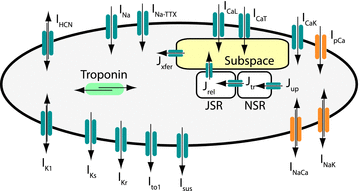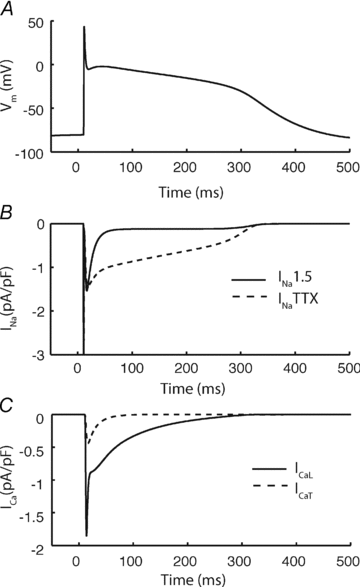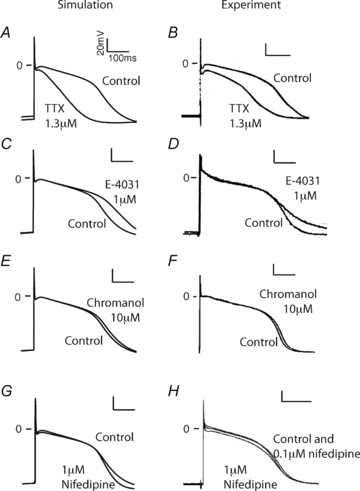A computational model of Purkinje fibre single cell electrophysiology: implications for the long QT syndrome
- PMID: 20498233
- PMCID: PMC2916994
- DOI: 10.1113/jphysiol.2010.187328
A computational model of Purkinje fibre single cell electrophysiology: implications for the long QT syndrome
Abstract
Computer modelling has emerged as a particularly useful tool in understanding the physiology and pathophysiology of cardiac tissues. Models of ventricular, atrial and nodal tissue have evolved and include detailed ion channel kinetics and intercellular Ca(2+) handling. Purkinje fibre cells play a central role in the electrophysiology of the heart and in the genesis of cardiac arrhythmias. In this study, a new computational model has been constructed that incorporates the major membrane currents that have been isolated in recent experiments using Purkinje fibre cells. The model, which integrates mathematical models of human ion channels based on detailed biophysical studies of their kinetic and voltage-dependent properties, recapitulates distinct electrophysiological characteristics unique to Purkinje fibre cells compared to neighbouring ventricular myocytes. These characteristics include automaticity, hyperpolarized voltage range of the action potential plateau potential, and prolonged action potential duration. Simulations of selective ion channel blockade reproduce responses to pharmacological challenges characteristic of isolated Purkinje fibres in vitro, and importantly, the model predicts that Purkinje fibre cells are prone to severe arrhythmogenic activity in patients harbouring long QT syndrome 3 but much less so for other common forms of long QT. This new Purkinje cellular model can be a useful tool to study tissue-specific drug interactions and the effects of disease-related ion channel dysfunction on the cardiac conduction system.
Figures







Comment in
-
Realistic cardiac electrophysiology modelling: are we just a heartbeat away?J Physiol. 2010 Aug 1;588(Pt 15):2689. doi: 10.1113/jphysiol.2010.194357. J Physiol. 2010. PMID: 20675816 Free PMC article. No abstract available.
Similar articles
-
Realistic cardiac electrophysiology modelling: are we just a heartbeat away?J Physiol. 2010 Aug 1;588(Pt 15):2689. doi: 10.1113/jphysiol.2010.194357. J Physiol. 2010. PMID: 20675816 Free PMC article. No abstract available.
-
Modeling tissue- and mutation- specific electrophysiological effects in the long QT syndrome: role of the Purkinje fiber.PLoS One. 2014 Jun 3;9(6):e97720. doi: 10.1371/journal.pone.0097720. eCollection 2014. PLoS One. 2014. PMID: 24892747 Free PMC article.
-
Preclinical cardiac safety assessment of pharmaceutical compounds using an integrated systems-based computer model of the heart.Prog Biophys Mol Biol. 2006 Jan-Apr;90(1-3):414-43. doi: 10.1016/j.pbiomolbio.2005.06.006. Prog Biophys Mol Biol. 2006. PMID: 16321428
-
Purkinje physiology and pathophysiology.J Interv Card Electrophysiol. 2018 Aug;52(3):255-262. doi: 10.1007/s10840-018-0414-3. Epub 2018 Jul 28. J Interv Card Electrophysiol. 2018. PMID: 30056516 Review.
-
QT interval prolongation and cardiac risk assessment for novel drugs.Curr Opin Investig Drugs. 2003 Mar;4(3):303-8. Curr Opin Investig Drugs. 2003. PMID: 12735231 Review.
Cited by
-
From sampling to simulating: Single-cell multiomics in systems pathophysiological modeling.iScience. 2024 Nov 5;27(12):111322. doi: 10.1016/j.isci.2024.111322. eCollection 2024 Dec 20. iScience. 2024. PMID: 39628578 Free PMC article. Review.
-
How the Hodgkin-Huxley equations inspired the Cardiac Physiome Project.J Physiol. 2012 Jun 1;590(11):2613-28. doi: 10.1113/jphysiol.2011.224238. Epub 2012 Apr 2. J Physiol. 2012. PMID: 22473779 Free PMC article.
-
Long-term memory in Staphylococcus aureus α-hemolysin ion channel kinetics.Eur Biophys J. 2023 Nov;52(8):661-671. doi: 10.1007/s00249-023-01675-8. Epub 2023 Aug 5. Eur Biophys J. 2023. PMID: 37542583
-
Computational optogenetics: empirically-derived voltage- and light-sensitive channelrhodopsin-2 model.PLoS Comput Biol. 2013;9(9):e1003220. doi: 10.1371/journal.pcbi.1003220. Epub 2013 Sep 12. PLoS Comput Biol. 2013. PMID: 24068903 Free PMC article.
-
Isolation and characterization of embryonic stem cell-derived cardiac Purkinje cells.Stem Cells. 2015 Apr;33(4):1102-12. doi: 10.1002/stem.1921. Stem Cells. 2015. PMID: 25524238 Free PMC article.
References
-
- Balati B, Varró A, Papp JG. Comparison of the cellular electrophysiological characteristics of canine left ventricular epicardium, M cells, endocardium and Purkinje fibres. Acta Physiol Scand. 1998;164:181–190. - PubMed
-
- Baruscotti M, DiFrancesco D, Robinson RB. Na+ current contribution to the diastolic depolarization in newborn rabbit SA node cells. Am J Physiol Heart Circ Physiol. 2000;279:H2303–H2309. - PubMed
Publication types
MeSH terms
Substances
Grants and funding
LinkOut - more resources
Full Text Sources
Miscellaneous

